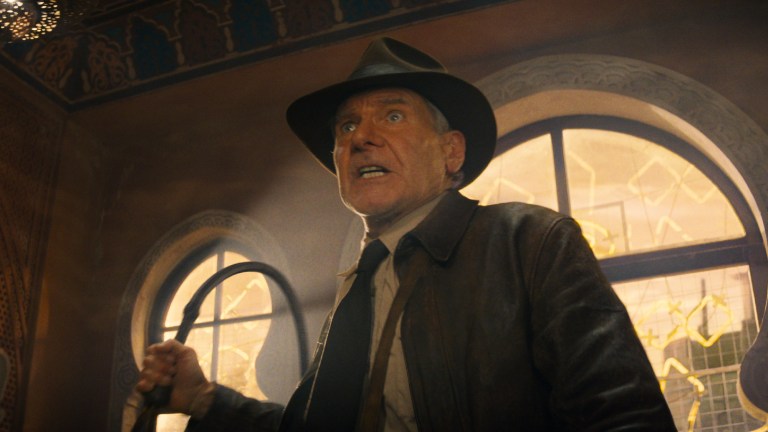Indiana Jones and the Dial of Destiny Review: Harrison Ford Can’t Rewind the Clock
Despite nods to former glories, it’s time for the Indiana Jones franchise to punch out.

“If I could turn back time…” Cher sang in 1989, coincidentally the same year that the last great Indiana Jones movie, Indiana Jones and the Last Crusade, came out. Rewinding the clock, both literally and figuratively, is very much on the minds of everyone involved in Indy’s fifth and apparently final adventure, Indiana Jones and the Dial of Destiny, as an aging Dr. Jones (Harrison Ford, of course) confronts his mortality, his regrets, and the sum total of his life’s accomplishments.
So it’s somehow appropriate that the MacGuffin which lures Indy out of his pending retirement for one last globe-trotting adventure is a device invented by the ancient Greek mathematician and physicist Archimedes that might somehow alter the course of history. If our hero gets his hands on the device—which, naturally, has been split into three pieces—will he be tempted to tamper with it?
It’s an interesting idea, but like many in Indy 5 (as we’ll call it from here on out), it is never explored to its full potential. For Indy and his few remaining allies, including Sallah (John Rhys-Davies in a walk-through-and-wave-at-the-audience appearance) and Helena “Wombat” Shaw (Phoebe Waller-Bridge), a late addition and goddaughter we never knew he had, their quest is simply to get hold of the Dial of Destiny before a surviving Nazi named Voller (a sleepwalking Mads Mikkelsen) can.
The audience’s quest, meanwhile, is to stay awake through it all. It gives me no pleasure to say that Indy 5 is a crashing bore; a bloated, tepidly paced slog of a movie that attempts to recapture the glories of this franchise’s past in much the same way that someone might blow on the dying embers of a fire to get it roaring again. The script and the characters go through all the same paces as before, with little development for any of them, but the whole 140-minute movie is dragged down by a noticeable lack of energy that neither its cast nor director James Mangold (taking over for Steven Spielberg) can replicate.
We saw Indy 5 at the Dolby Theater in Hollywood, where the film was projected in Dolby Vision with Dolby Atmos sound. The sound was one of the bright spots for the movie, and perhaps its finest technical achievement, with the Atmos technology creating a fully immersive, expansive experience and bringing forth John Williams’ outstanding score with a clarity and scope we’ve often not heard in a theater.
The Dolby Vision image was noticeably crisp and clear as well—if only every theater had this kind of projection available to it—but the clarity of the image also highlighted the fact that much of this movie, including its overlong 20-minute opening sequence, is dependent on CG in a way that even 2008’s Indiana Jones and the Kingdom of the Crystal Skull was not.
That opening sequences is set in 1944, where we find Indy and Marcus Brody stand-in Basil Shaw (Toby Jones) in pursuit of the Lance of Longinus (the spear used to stab Christ while he was on the cross), which is in the hands of the Nazis, along with other looted artifacts. Supervising the operation is Voller, who has also stumbled upon the much more powerful Dial of Destiny and wants to bring it back to his superiors. Indy, of course, gets in the way, resulting in that opening sequence that climaxes atop a train that goes tumbling off a bridge as it’s bombed by the Allies.
This is the controversial sequence in which Ford is de-aged to look like himself circa the early 1980s, when he first played Indy. And at first it looks pretty damn good, but the seams begin to show over the course of the next 20 minutes. It’s not helpful that the rest of the sequence looks overly glossy or CG-ed into existence, with the backdrop of rushing landscape as Indy and Voller fight it out atop the speeding train making it almost painfully obvious that it’s shot in the digital landscape known as the Volume.
Flash forward 25 years to 1969, the counterculture is in full swing, and an old, embittered Indy is preparing to retire from his job as professor of archaeology at New York City’s Hunter College. We find out that Marion Ravenwood (Karen Allen) and he, after marrying in Indy 4, are separated, their relationship frayed by tragedy. Perhaps not since the beginning of Alien 3, when Newt and Corporal Hicks were quickly dispatched after Ripley’s hard-fought battle to save them at the end of Aliens, has the emotional arc of the previous film been so thoroughly reversed—and offscreen, no less.
Enter Helena, who surfaces to retrieve the portion of the Dial that Indy and her late dad managed to save so that she can sell it to the highest bidder in Tangiers. Indy pursues her there, with Voller—who is now working for the U.S. government—and his henchmen in pursuit. Indy catches up to Helena and convinces her (or so he thinks) that the Dial cannot be sold, and they instead head out to find the remaining two pieces before Voller can get his evil Nazi hands on it.
Along the way, Indy 5 settles into what could be charitably described as a stop-and-start rhythm, but more accurately feels like a torpor. They stop for some exposition, usually delivered by Helena or a new character, then start on the next chase and set piece. Everything feels perfunctory, not arising from the flow of the story or characters but because this is an Indiana Jones movie, and we need to see these things. And for every introduction of a lovely, real location—the desert or Sicily—there is a clearly fake New York City and a heavily digitized pursuit through a subway tunnel.
New characters include Teddy Kumar (Ethann Isidore), a young boy who works with Helena and is clearly meant to induce memories of Short Round; Klaber (Boyd Holbrook), Voller’s right hand man whose job is to look as sinister as possible; Mason (Shaunette Renée Wilson), a CIA agent who is set up as a potentially important character and then… isn’t; and Renaldo, an old friend of Indy’s (who we never heard of in four previous pictures) and deep sea diver whose primary reason for being in the movie is to give Antonio Banderas a chance to say he was in an Indiana Jones movie.
Waller-Bridge brings some fresh energy to the proceedings for a while, but she ultimately becomes irritating; her character’s motivations veer back and forth depending on what the scene requires or what needs explaining. She and Ford do share a few good verbal volleys from time to time. And then there’s the man himself. He’s still charismatic and physically imposing, drawing in a few scenes on a well of vulnerability that we’ve not seen before from this character. It’s hard not to feel the pull of just how iconic both Indy and the actor who plays him are. Yet there are a lot of other moments where he seems as disengaged and bored as we found ourselves more or less after the first act.
By the time we get to the third act, the narrative pushes into ridiculous, noisy, overstuffed new directions that offer neither thrills nor wonder, nor delight, but just a sinking feeling that the saga has managed to outdo Kingdom of the Crystal Skull in sheer absurdity. When one character punches out another’s lights and the screen goes black, it feels almost merciful. But then there is a coda that so desperately wants to pull at our heartstrings—even if the previous two hours haven’t done a goddamn thing to earn that—that we almost felt bad for all involved.
Almost, but not quite. Ford, Mangold, producers Kathleen Kennedy, Frank Marshall, and everyone else signed off on this script (we have to wonder if Spielberg even looked at it) without really stopping to think about what story they wanted to tell. Then they created a shiny, overly digitized movie for 2023 without remembering the practical, hard-crafted feel of the ones they made in the 1980s.
If they wanted this movie to be one more grand Indy adventure, they muffed it; if they wanted this to be an emotional farewell to one of the most famous characters in cinema history, they blew that too. By the time Indiana Jones and the Dial of Destiny runs down and stops, all we are left with are a few fleeting tingles of nostalgia and the desire to indeed turn back time—so that we can go back to 1989 and tell all these folks to leave well enough alone.
Indiana Jones and the Dial of Destiny opens in theaters Friday, June 30.
